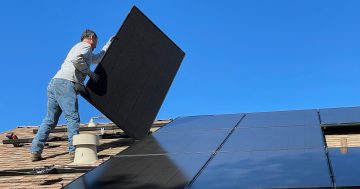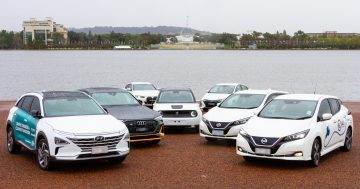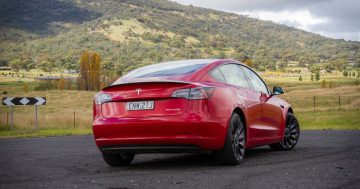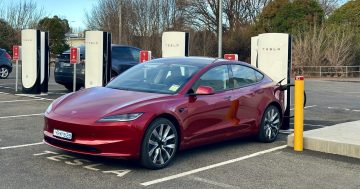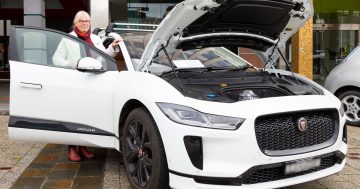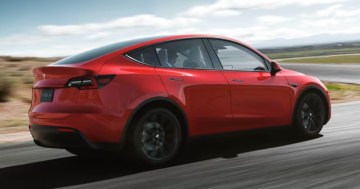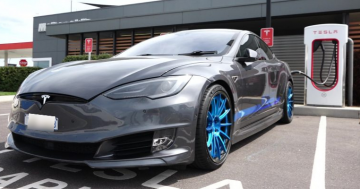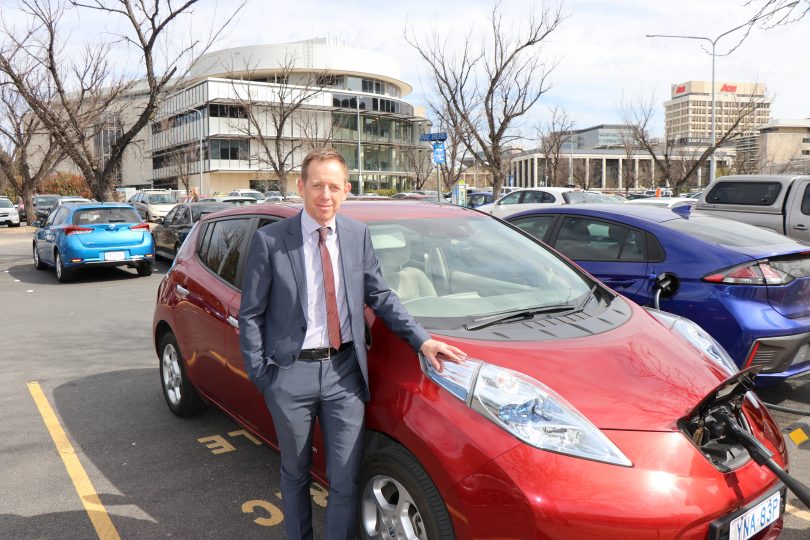
Minister for Emissions Reduction, Shane Rattenbury and an electric vehicle: “Many Canberrans want to take action on climate change, and these no-interest loans for zero-emissions vehicles will help people to do this.” Photo: Supplied.
Buying an electric vehicle will now be more affordable in the ACT, with Canberrans able to for an interest-free loan up to $15,000 through the ACT Government’s expanded Sustainable Household Scheme.
Adding the EV option to the scheme had been flagged, and the government is today opening loan applications, which will help, along with two years’ free rego and zero stamp duty, overcome the considerable cost barrier to buying an electric vehicle.
The government says the expansion will start with a small number of electric vehicle suppliers participating in the scheme, but more suppliers will be added over time.
Many new and used electric vehicle dealerships are already signed up as participants.
The move will support the government’s policy aim of net-zero emissions by 2045.
Chief Minister and Minister for Climate Action Andrew Barr said the goal was to support more Canberra households to share in the benefits of a net-zero emissions future while at the same time creating and protecting good local jobs.
“So far, the scheme has been a great success, and we look forward to seeing more Canberrans support the government’s efforts to reduce emissions without leaving people behind,” he said.
Minister for Emissions Reduction Shane Rattenbury said transport was the largest contributor of greenhouse gas emissions in the ACT, and this latest move would be another incentive for Canberrans to switch to electric vehicles.
“Many Canberrans want to take action on climate change, and these no-interest loans for zero-emissions vehicles will help people to do this,” he said.
“With two years’ free registration and zero stamp duty on emission-free vehicles already in place in the ACT, this initiative makes it even easier for Canberran households to reduce their emissions and take that next step.
“I look forward to seeing more zero-emissions vehicles on the roads as we work towards net-zero by 2045.”
Brighte has partnered with the government to be the loan provider for the scheme.
CEO Katherine McConnell said that between home energy and personal vehicles, households generated 33.5 per cent of the ACT’s domestic emissions.
“The future is electric, and EVs are at a tipping point of affordability — programs like the Sustainable Household Scheme make this transition more possible. I have no doubt the ACT will become a territory of zero-emission vehicles and lead the way for other states to follow suit.”
The price of EVs remains prohibitively high for many, but they are expected to become cheaper over time.
The Federal Government is investing in charging stations but has resisted industry calls for a CO2 fuel efficiency standard, which carmakers say would make Australia more attractive for them to sell into, increasing the variety of models in the market.
Through phase one of the Sustainable Household Scheme, more than 2000 households have already applied to have sustainable upgrades installed in their homes, with around $20 million in loan applications received so far.
The government says it has also provided a welcome boost to the local industry, with more than 80 per cent of work generated going to ACT and region suppliers.
Under the scheme, eligible applicants can borrow to buy rooftop solar panels, household battery storage systems, electric heating and cooling systems, hot water heat pumps, electric stovetops, installation costs for these products, and now EVs.
The guidelines and more information about the scheme, including how to apply for a loan, are available on the government’s climate choices website.













